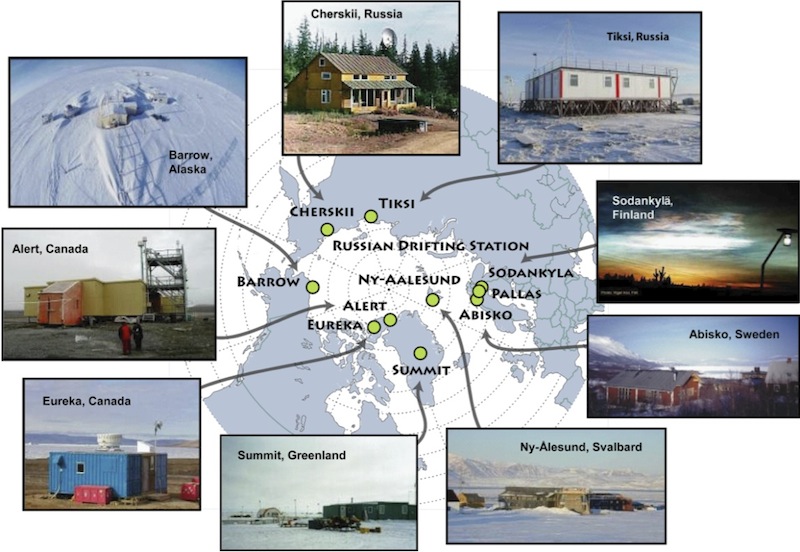
[ Archive ]

 |
ASPB and CIMSS Weekly Report
[ Archive ] |
 |
IN THE PRESS:
ITEMS FOR THE ADMINISTRATOR:
ITEMS FOR THE ASSISTANT ADMINISTRATOR:
Tiksi Atmospheric Observatory Science Team Meeting: NOAA/OAR
and the National Science Foundation (NSF) have devoted consider time
and financial resources to establishing a Russia-U.S. joint
meteorological station at Tiksi, Russia. Tiksi is a small city on the
coast of Siberia. It is an ideal location for studying Arctic
meteorology and climatology, and a perfect complement to other
“atmospheric observatories” operated by NOAA across the Arctic. After
years of preparations, the project can now move from a state of
establishing a joint Roshydromet-NOAA Observatory in Tiksi to operating
the observatory. To mark this transition, the Russian Federation for
the Hydrometeorological and Environmental Monitoring (Roshydromet)
officially requested U.S. participation in the first Tiksi Science
Meeting, held in Saint Petersburg, Russia, 18-19 September 2012. NESDIS
is represented on the Tiksi Science Team (J. Key, STAR). The meeting was
hosted by the Arctic and Antarctic Research Institute (AARI). After two
days of discussing measurement types, science applications, logistics,
and bureaucratic issues, a protocol establishing the path forward for
collaboration on Tiksi observations was signed by representatives of
NOAA and AARI. (J. Key, E/RA2, 608-263-2605, jkey@ssec.wisc.edu)
Significance: NESDIS' role in this project is to provide advice on the
types of surface measurements that will aid in the validation of
satellite products, and to provide guidance on the use of satellite
products for Tiksi science applications. Additionally, Tiksi is being
considered as a contribution to the World Meteorological Organization’s
Global Cryosphere Watch (GCW) network of surface stations, called
“CryoNet”. NESDIS/STAR is co-leading the development and implementation
of GCW. GCW is a component of the WMO Integrated Global Observing System
(WIGOS) and, therefore, part of the Global Earth Observation System of
Systems (GEOSS).
NOAA
Mission Goals: Serve Society's Needs for Weather and Water
Information; Understand Climate Variability and Change; Support the
Nation's Commerce
NOAA Cross-Cutting Priorities: Sound, Reliable State-of-the-Art
Research; Integrating Global Environmental Observations and Data
Management
 (Click image to enlarge)
(Click image to enlarge)
Figure caption: Locations of Arctic atmospheric observatories in which NOAA plays a key role.
ITEMS FOR THE OFFICE DIRECTOR, STAR:
WMO/Thorpex Data Assimilation and Observing System Working Group Meeting Hosted by UW/SSEC/CIMSS: The 5th meeting of the World Meteorological Organization's (WMO) THORPEX (THe Observing system Research and Predictability EXperiment) working group (WG) on atmospheric Data Assimilation and Observing Systems (DAOS) was held on the campus of the University of Wisconsin-Madison, 19-20 September 2012. The Cooperative Institute for Meteorological Satellite Studies (CIMSS)/Space Science and Engineering Center (SSEC) served as the local host. The WG meets annually, and consists of international scientists and experts in the disciplines of numerical data assimilation and the global observing system. The first day was dedicated to reviewing recent activities and accomplishments of the group followed by presentations on targeting observations, recent observation campaigns, and general observational developments. The second day was dedicated to recent advances in data assimilation, primarily focusing on assimilation techniques, the computation of model errors, and forecast accuracy assessment methodologies. The WG heard from several SSEC, CIMSS, and Advanced Satellite Products Branch (ASPB) scientists on topic-relevant issues, including presentations on geostationary hyper-spectral sounders (H. Revercomb, SSEC), satellite observations (C. Velden, CIMSS), atmospheric motion vectors (AMVs) (D. Santek, CIMSS), aerosol assimilation and modeling (B. Pierce, ASPB), and diagnosing data targeting approaches (B. Hoover, CIMSS). The WG will assemble recommendations and actions from the meeting to be forwarded to the WMO Commission on Atmospheric Sciences (CAS) and the THORPEX International Science Steering Committee. (C. Velden, CIMSS, 608-262-9168; R. Aune, E/RA2, 608-262-1071)
Keynote to International RGB workshop: T. Schmit (remotely) gave a keynote presentation on September 18, 2012 at the World Meteorological Organization (WMO)/ European Organisation for the Exploitation of Meteorological Satellites (EUMETSAT) Workshop on Red-Green-Blue (RGB) Satellite Products. The presentation was titled “Moving from "versus" quantitative products to RGB “with” quantitative products”. Examples from the Geostationary Operational Environmental Satellite (GOES) imagers and sounders were shown. The presentation is available at ftp://ftp.ssec.wisc.edu/ABI/RGB/Schmit_RGB_workshop_final.pptx. The workshop was held in Seeheim, Germany. (T. Schmit, E/RA2, 608-263-0291, tim.j.schmit@noaa.gov)
ITEMS FOR THE DIVISION CHIEF, CoRP:
Unidata Users Committee: Tom Whittaker (Cooperative Institute for Meteorological Satellite Studies, CIMSS) attended his last meeting as Chair of the Unidata Users Committee. During his 30+ years of participation on various Unidata committees, including 10 years on the Users Committee, he has provided technical advice and input from the community into the development of various Unidata projects, such as the Network Common Data Format (netCDF), the Local Data Manager (LDM), Thematic Realtime Environmental Distributed Data Services (THREDDS), and the Integrated Data Viewer (IDV), upon which the Man-computer Interactive Data Access System V (McIDAS-V) is built. Unidata is a National Science Foundation (NSF) sponsored project that provides real-time data and related tools to more than 200 academic and government organizations. (T. Whittaker, CIMSS)VISITORS:
NEXT WEEK:
LOOKING AHEAD:
| Archived Weeklies Page | Submit a report item |